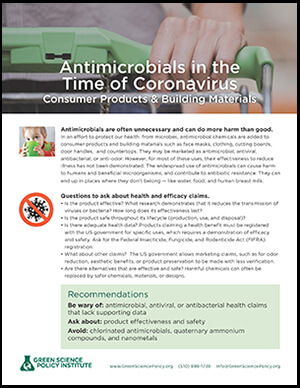September 2020 : Sun, Smoke & Mirrors
In this edition:
- Aerial Fire Retardants: It’s Raining Red
- Deep-six the C6?
- Water Filtration May Reduce Reproductive Harm from PFAS
- Brominated Flame Retardants in Soft Drinks?
- Welcome Carol Kwiatkowski, PhD, Our Institute’s New Science and Policy Team Member
- CALENDAR
Here in California, our environment has been uniquely problematic these last days. High smoke from numerous forest fires blocked the sun so one day it seemed like we were having a solar eclipse for many hours. When the smoke dropped down, so did air quality, which has remained very unhealthy across much of the West. We at the Institute feel fortunate to be able to continue working from our homes on projects for a healthier environment along with our academic, government, business and NGO colleagues. We do hope to emerge from our current multiple crises empowered to address the interlinked problems of toxic chemicals, climate change and plastic pollution as discussed during our 2020 Six Classes retreat.
For now, we continue our scientific and policy work to reduce the use of chemical classes of concern. Since the pandemic began, the use of unnecessary and harmful antimicrobials has increased, and we are working to address that. Please check out our new fact sheet “Antimicrobials in the Time of Coronavirus: Consumer Products and Building Materials” where we describe how antimicrobials in many products are not needed and can do more harm than good. You can learn questions to ask about the possible adverse health impacts and efficacy of antimicrobials in products being marketed to you as a consumer, retailer, or manufacturer.
We have heard many times that soap and water are more effective at washing away viruses than are antimicrobials. But did you know water is also washing away your blue jeans every time you launder them? And not only down the drain, but all the way to the Arctic. A recent paper found that over 50,000 microfibers can be shed from blue jeans every time they’re washed, and the fibers are ending up in fish and lake sediment in remote regions of the world. Although “natural”, these fibers are processed with dyes and other chemical additives. They are also persistent enough to survive long-range transport, raising concern over their impact on aquatic ecosystems. One way to help-wash your denim less!
What else has been found in the Arctic? The PFAS known as GenX, which was identified for the first time in currents entering and exiting the Arctic Ocean. The research vessel collecting the samples also identified 10 other PFAS. The long-range transport of these chemicals is a serious concern for the environment and human health. The authors of the study hypothesize that PFAS deposition from the atmosphere and release from melting snow and ice are important contributors.
I am pleased to welcome our Institute’s new team member, Dr. Carol Kwiatkowski, who joins us from her home office in Colorado. You can learn more about Carol, who was the Executive Director of the scientific NGO TEDX, from her bio at the end of this email.
Finally, I want to remind you to begin making your plan on where and how you will vote and encourage your friends and family to do the same. Now is the time to donate and volunteer–make calls, write postcards–for the candidates of your choice and the future you want for our world. Friends and I put together a list of suggestions on volunteering, so please write me if you’d like to see it. Also, remember to vote as early as possible and fill out your 2020 Census Form.
Looking forward to better times,
Arlene and the Green Science Policy team
P.S. – Our Institute has an open position for a Science and Policy Associate to help us work towards reduced toxics in a healthier world. Learn more on our jobs page.
Aerial Fire Retardants: It’s Raining Red
Tragically, this is already the worst fire season on record here in California and across the Western states, with unprecedented devastation from hundreds of simultaneous and uncontrolled wildfires.Are the bright red trails of fire retardant chemicals being dropped from airplanes to battle these blazes also harming people and wildlife? The good news is that aerial flame retardants are not the persistent, bioaccumulative and toxic chemicals that used to be added to furniture foam and are still used in plastic TV cases and building insulation.
Most wildland fire fighting products are water based and not considered harmful to humans. However, they can cause unintended harm to ecosystems if they are not used carefully. Components of these mixtures can be toxic to aquatic life (for example, if they are dropped into streams). To prevent this, the US Forest Service has a policy of not dropping retardant within 300 feet of waterways.
And that alarming bright red color is a dye added to mark areas where retardant has been dropped. Learn more in our blog.
Deep-six the C6?
By Tom Bruton
The US Food and Drug Administration (FDA) recently announced that manufacturers of certain short-chain PFAS used in food packaging are voluntarily pulling those chemicals from the market. The phase-out involves a subset of the “C6” PFAS compounds, and will impact nearly one half of PFAS that are registered with FDA for grease-proofing of paper and paperboard food packaging.
These short-chain PFAS are close chemical cousins of the hazardous long-chain PFAS that were previously phased out of food packaging. We have maintained for years that the C6 compounds are likely regrettable substitutes.
Why the change now? A new analysis by FDA researchers showed that one of the metabolites of the C6 PFAS can be just as biopersistent as the old long-chain chemicals. In other words, it is eliminated from the body slowly, giving it more time to potentially do damage. While the new phase-out should have happened sooner, it’s a significant step, and FDA scientists deserve credit for taking a fresh look at the evidence. Let’s hope there are more steps to come.
Meanwhile, scientists at the European Food Safety Authority announced a new, lower safety threshold for four of the more biopersistent PFAS. The new tolerable weekly intake for PFOS, PFOA, PFNA, and PFHxS is 4.4 nanograms per kilogram of body weight per week. This extremely low level reinforces that we should reduce unessential uses of PFAS as soon as possible.
Water Filtration May Reduce Reproductive Harm from PFAS
By Carol Kwiatkowski
An innovative study of PFAS exposure in Minnesota drinking water indicated that water filtration may have reduced adverse birth outcomes in affected communities. Birth records from over 48,000 babies were analyzed before and after installation of granular activated charcoal water filtration in a community which previously had extremely high levels of PFAS caused by industrial contamination from 3M. Prior to filtration, PFAS exposure was associated with increased odds of low birth weight, pre-term birth, and lowered fertility compared to control communities. After the facility was installed, the differences decreased. This “natural experiment” demonstrates the importance of monitoring drinking water for PFAS and providing affected communities with clean drinking water. On the other hand, the Minnesota Department of Health analyzed similar data, but found different results and conclusions.
Brominated Flame Retardants in Soft Drinks?
By Kayla Rude
Changing the California furniture standard so that flame retardants are no longer needed in furniture and baby products has reduced brominated chemicals in our homes and our bodies. However, brominated vegetable oils (BVOs), originally patented as flame retardants, have been added to some citrus soda drinks to emulsify flavoring oils and give these soft drinks the cloudy look of real fruit juice. Drinking more than two liters a day of BVO-containing sodas can lead to severe bromine toxicity (e.g. tissue damage) requiring medical treatment. In fact, BVOs have been banned for decades in the EU and Japan.
Nonetheless, the US FDA still allows BVOs up to 15 parts per million to be used as food additives. According to one 2012 study, “the average daily human intake of BVO [from BVO- containing sodas] exceeds the intake of other organobromine compounds, such as brominated flame retardants, by more than 4000 times for adults and more than 1000 times for children.” Our good news is that recently most companies have recently phased out BVOs, including PepsiCo and Coca-Cola. However, a few soft drinks such as Fresca peach citrus, and some Sundrop flavors still contain BVOs. The market is ahead of the FDA!
Welcome Carol Kwiatkowski, PhD, Our Institute’s New Science and Policy Team Member

Carol Kwiatkowski is the former director of the science based non-profit “The Endocrine Disruption Exchange”. She has many years of experience evaluating scientific studies of environmental chemicals that affect human health. Her past work focused on sharing this information with a variety of stakeholders through peer-reviewed publications, online databases, systematic reviews, webinars, and podcasts. After earning her PhD from the University of Denver, and working as an Assistant Professor at the University of Colorado, she joined the non-profit sector, where she has been since 2007.
She also holds a position as an Adjunct Assistant Professor at North Carolina State University. Carol is passionate about using her work to prompt action that will make the world a better place for her children.
CALENDAR
October 15 & 16, 2020: Green Science Policy Workshop on Science & Policy of PFAS
An interactive two-session virtual workshop, following the PFAS in Our World meeting
When: 1:00 PM – 3:30 PM Eastern
Questions: [email protected]
October 19-23, 2020: CWEA PFAS Summit
Arlene Blum will keynote the PFAS Summit at the California Water Environment Association (CWEA) Annual Conference. Her talk is entitled: “PFAS: What It is, What It Comes From, Where It’s Found and Its Dangers”.
November 30 & December 1: PFAS Conference in Berlin
Arlene Blum will be the keynote speaker for the PFAS conference, Dealing with Contaminants of Emerging Concern, sponsored by the German Environment Agency and the German Ministry for the Environment. Her presentation is entitled: “Reducing Harm from PFAS for a Healthier Environment”.
Where: Berlin, Germany
Receive Updates By Email
Subscribe to our monthly newsletter and get these updates delivered right to your inbox!




